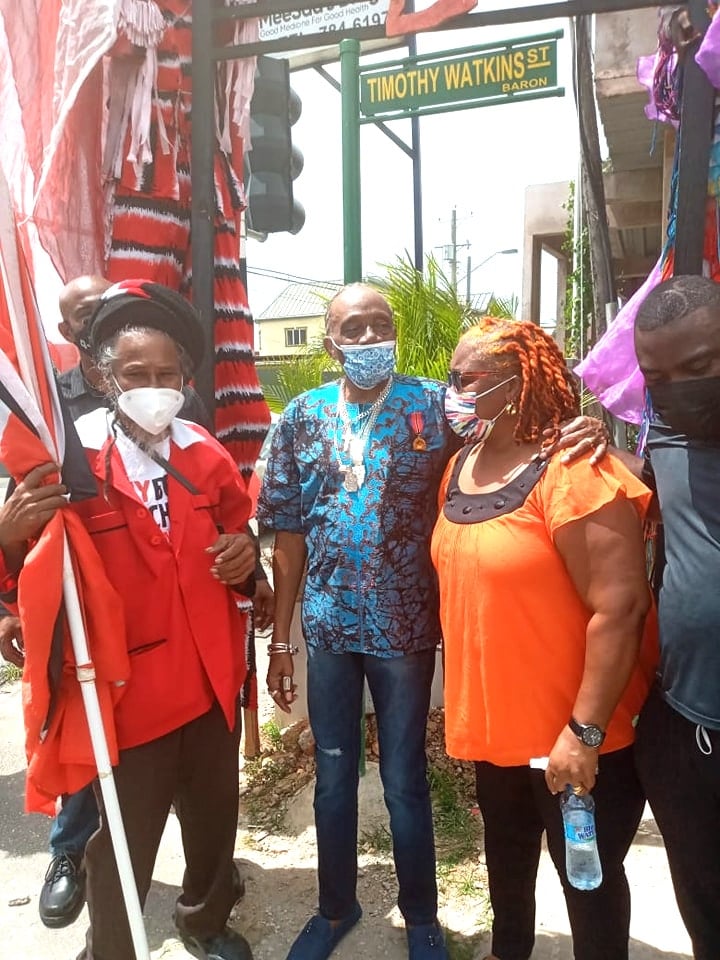|
Congrats
to TIMOTHY WATKINS (Baron) for getting a street after his name where he was born .. Well deserved
0 Comments
Read the story here
or copy and paste this url into your browser: https://tt.loopnews.com/content/tt-national-ranks-1-amazon-best-seller-list-again?fbclid=IwAR0bWdkSIHt9JOH8HCuvcn-3VI-w4QS6MFY3njB95HppazFAmKoE1_htSqc Trinidad & Tobago may only be 7 miles off the coast of Venezuela but the country that's had an outsize influence on its food is India. Foodways historian Ramin Ganeshram explains how that came to be.
The best part of the childhood summers I spent on my father's home island of Trinidad was trailing behind him on his visits to the market to shop for his older sisters. All around us, tables were laden with the riotous hues of red Scotch bonnet peppers, orange pumpkins and mangoes, yellow bananas, rich purple eggplant, green long beans—called by their Hindi name, bodi—bitter melon, spinach and other edible leaves. Sometimes the colors were so bright they hurt your eyes. My favorite stop, though, was one particular spice stand—I've long forgotten the name, it was 40 years ago, after all—with its huge barrels of spices: cardamom, turmeric, cinnamon, cumin. The owners, three brothers of East Indian descent, sold their wares with a singularly Trinidadian marketing technique—by freestyling calypsos (storytelling songs native to the island) about the superiority of their spices. In those days, many folks were still mixing their own curry— a key ingredient in much of the island's cuisine. The brothers had their own special blend, a recipe that had been a part of their family since their ancestors first arrived in Trinidad as indentured laborers in the 19th century. Their story is similar to my family's. At least three of my father's grandparents traveled from Punjab, India, to Trinidad in the 1850s. As bonded field workers, they farmed sugar and cocoa fields for the English who, needing an other cheap source of labor following the end of slavery in their colonies, looked to other brown nations like India and China. Along with half a million others, theirs was a story of British imperial hegemony, which moved Indian people across the globe as indentured laborers to places like Trinidad and Guyana in the Western Hemisphere and Fiji and Mauritius in the Southern Hemisphere. In the Caribbean, my Indian ancestors took over where slavery left off. My great-grandparents' immigration was a forced one, the details of which are murky. Poverty, starvation, oppression and deception all surely played a part. Once they arrived in Trinidad, they suffered the brutality of the plantation system. Still, they found ways to sustain their heritage by retaining their languages (which became pidginized in later generations), wearing native clothes and worshiping their gods. India remained a distant memory kept alive by the foods they eked out despite desperate poverty. Curry became a stand-in for Indianness at large. Ingredients like rice, turmeric, cardamom, yogurt and ghee, along with typical Indian cooking techniques, melded with local produce in new ways. Today, nearly half of the population on the island claims Indian roots. In both its people and its cuisine, Trinidad is an organic fusion. Here, the flavors from the subcontinent have married with those from West Africa, China and Syria and of the Indigenous people. Curry is still a foundational flavor, and everything from fruits and vegetables to meat, fish and wild game gets equal opportunity in the curry pot. For most Trinidadians, Indian culture is simply part and parcel of the nation. Colette Cyrus Burnett, a chef and CEO of Global Food Warrior, which strives to make local food systems more affordable and accessible, grew up in Chaguanas, an area in central Trinidad that is known for its strong Indian roots. Although largely AfroCaribbean, she recognizes TrinidadIndian food as core to the national identity. "We never saw any distinction in our kitchen. It was never 'East Indian' food to us," she says. "It is just home food, a part of our collective culture that warms our hearts and bellies." And so it is for me. When I cook a dish that I learned from my father, I'm transported back to those summers on Trinidad. The tangy tamarind sauce spooned over fish, the aroma of curry in doubles and the smoky flavor of roasted eggplant, all speak to this diverse nation's deliciously complex history. (Source: Eating well, Ramin GaneshramFebruary 18, 2022)  After presenting under his namesake label, Maximilian, in the Fashion East showcase during London Fashion Week for the second and final time, Maximilian Davis is taking on new territory. The Italian fashion house Salvatore Ferragamo has recently appointed Davis as the brand’s new Creative Director. “I am deeply honored to be joining Ferragamo, and grateful for the opportunity to build on the rich and profound heritage of the house,” said Davis in a press release. “Ferragamo represents a dedication to timeless elegance and sophistication that I find incredibly inspiring. I’m looking forward to articulating my vision, elevated by the codes of Italian craftsmanship, quality and innovation.” Davis is known for referencing his Trinidadian heritage under his eponymous label, and his signature Harlequin print has become one of the distinctive, identifiable House codes in the industry. It will be most interesting to see how Davis will infuse his perspective and Black culture into the coming collections for the Italian House that is known for its footwear and leather goods. Reports say Davis will be putting his namesake label on hold to focus solely on his new role. Marco Gobbetti, CEO at Salvatore Ferragamo, expressed in the release, “I am delighted to welcome Maximilian at the House of Ferragamo. The clarity of his vision together with the level of execution and his powerful aesthetic make him one of the most brilliant talents of his generation. His work is defined by elegance, refined sensuality, and constant commitment to quality. Through his lens of contemporary sensibility, he will write a new, exciting chapter for this house built on a heritage of creativity, craftsmanship, sophistication, and outstanding human values.” The appointment of Davis as Ferragamo’s new Creative Director also marks a historical moment in the company’s history as he becomes the first Black Creative Director to ever lead the Italian fashion house – his appointment will officially begin on March 16th. (Source: Essence, March 14, 2022) |
T&T news blogThe intent of this blog is to bring some news from home and other fun items. If you enjoy what you read, please leave us a comment.. Archives
May 2025
Categories
All
|





 RSS Feed
RSS Feed